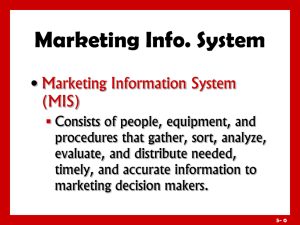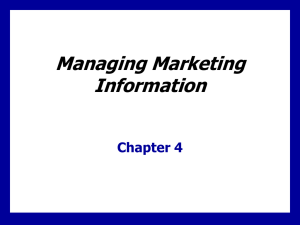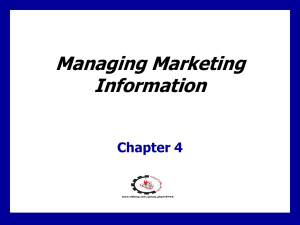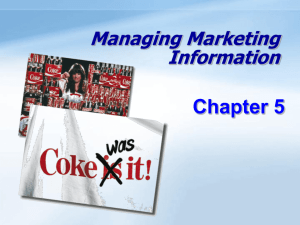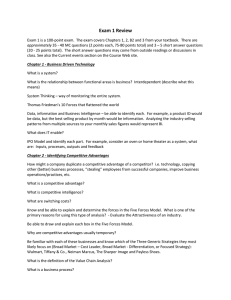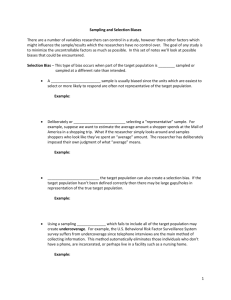Managing Marketing Information
advertisement
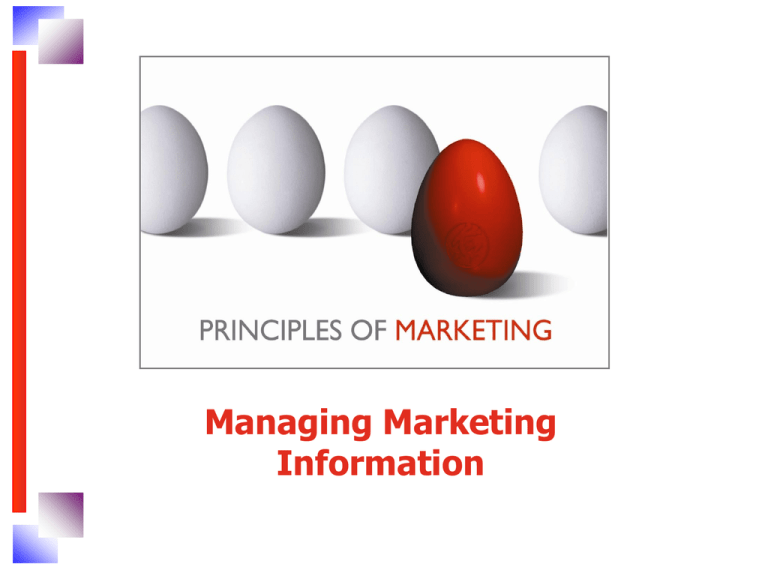
Managing Marketing Information Learning Goals 1. Explain the importance of information to the company 2. Define the marketing information system 3. Outline the steps in the market research process 4. Explain how companies analyze and distribute information 5. Discuss special issues facing market researchers 4-2 Learning Goals 1. Explain the importance of information to the company 2. Define the marketing information system 3. Outline the steps in the market research process 4. Explain how companies analyze and distribute information 5. Discuss special issues facing market researchers 4-3 Case Study New Coke New Coke product failure • Poor sales • Over 1,500 phone calls a day from angry customers • Old coke returns in only 3 months Due largely to research failure • Tested on taste only – not intangibles • Decisions based on 60% ratings • All for $4 million! 4-4 Learning Goals 1. Explain the importance of information to the company 2. Define the marketing information system 3. Outline the steps in the market research process 4. Explain how companies analyze and distribute information 5. Discuss special issues facing market researchers 4-5 Marketing Information System • Marketing Information System (MIS) – Consists of people, equipment, and procedures to gather, sort, analyze, evaluate, and distribute needed, timely, and accurate information to marketing decision makers. 4-6 Marketing Information System Figure 4.1 4-7 Marketing Information System • Interacts with information users to assess information • Develops needed information from internal and external sources • Helps users analyze information for marketing decisions • Distributes the marketing information and helps managers use it for decision making 4-8 PeopleSoft markets databases to optimize customer relationship management 4-9 Marketing in Action Assessing Marketing Information Needs • The MIS serves company managers as well as external partners • The MIS must balance needs against feasibility: – Not all information can be obtained – Obtaining, processing, sorting, and delivering information is costly 4 - 10 Developing Marketing Information Sources of Info • Internal data • Marketing intelligence • Marketing research • Internal data is gathered via customer databases, financial records, and operations reports • Advantages include quick/easy access to information • Disadvantages stem from the incompleteness or inappropriateness of data to a particular situation 4 - 11 This ad is targeted to businesses to reinforce the importance of a good internal data for an MIS system 4 - 12 Marketing in Action Developing Marketing Information Sources of Info • Internal data • Marketing intelligence • Marketing research • Marketing intelligence is the systematic collection and analysis of publicly available information about competitors and trends in the marketing environment. • Competitive intelligence gathering activities have grown dramatically. • Many sources of competitive information exist. 4 - 13 Sources of Competitive Intelligence • Company employees • Internet • Garbage • Published information • Competitor’s employees • Trade shows • Benchmarking • Channel members and key customers 4 - 14 Developing Marketing Information Sources of Info • Internal data • Marketing intelligence • Marketing research • Marketing research is the systematic design, collection, analysis, and reporting of data relevant to a specific marketing situation facing an organization. 4 - 15 Greenfield Online runs a teen panel for feedback to clients on this important market Marketing in Action Click on screenshot for website 4 - 16 Learning Goals • Explain the importance of information to the company • Define the marketing information system • Outline the steps in the market research process • Explain how companies analyze and distribute information • Discuss special issues facing market researchers 4 - 17 Steps in the Marketing Research Process Figure 4.2 4 - 18 Step 1: Defining the problem and research objectives • The manager and the researcher must work together. • These objectives guide the entire process. • Exploratory, descriptive, and causal research each fulfill different objectives. 4 - 19 Step 2: Developing the Research Plan • Research plan is a written document which outlines the type of problem, objectives, data needed, and the usefulness of the results. Includes: – Secondary data: Information collected for another purpose which already exists – Primary data: Information collected for the specific purpose at hand 4 - 20 Secondary Data • Secondary data sources: – Government information – Internal, commercial, and online databases – Publications • Advantages: – Obtained quickly – Less expensive than primary data • Disadvantages: – Information may not exist or may not be usable 4 - 21 Secondary data on female spending has prompted marketing changes at retailers Source: Business Week Marketing in Action 4 - 22 Evaluate the Following when Judging Data Quality • Relevance • Accuracy • Currency • Impartiality 4 - 23 Primary Data • Primary research decisions: – Research approaches – Contact methods – Sampling plan – Research instruments 4 - 24 Primary Data Decisions • • • • Research Approach Contact Method Sampling Plan Research Instrument • Observation research using people or machines – Discovers behavior but not motivations • Survey research – Effective for descriptive information • Experimental research – investigates cause and effect relationships 4 - 25 Primary Data Decisions • • • • Research Approach Contact Method Sampling Plan Research Instrument Key Contact Methods include: – Mail surveys – Telephone surveys – Personal interviewing: • Individual or focus group – Online research 4 - 26 Strengths and Weaknesses of Contact Methods Relate to: • • • • Flexibility Sample control Data quantity Cost • Interviewer effects • Speed of data collection • Response rate 4 - 27 Primary Data Decisions • • • • Research Approach Contact Method Sampling Plan Research Instrument • Sample: subgroup of population from whom information will be collected • Sampling Plan Decisions: – Sampling unit – Sample size – Sampling procedure: • Probability samples • Non-probability samples 4 - 28 Primary Data • • • • Decisions • Questionnaires – Include open-ended Research Approach Contact Method Sampling Plan Research Instrument • Mechanical instruments – Nielsen’s people and closed-ended questions – Phrasing and question order are key meters – Checkout scanners – Eye cameras 4 - 29 Eye Cameras • Eye cameras track the consumer’s eyes as they look at marketing materials • Applications – print ads – where do people look first? – Web pages – do people view banner ads? – Other web applications? 4 - 30 Marketing in Action Discussion Question A digital camera manufacturer wants to determine what is most important to older (50+) camera buyers Suggest a research approach, contact methods, sampling plan, research instruments 4 - 31 Step 3: Implementing the Research Plan • Data is collected by the company or an outside firm • The data is then processed and checked for accuracy and completeness and coded for analysis • Finally the data is analyzed by a variety of statistical methods 4 - 32 Step 4: Interpreting and Reporting the Findings • The research interprets the finding, draws conclusions and reports to management • Managers and researchers must work together to interpret results for useful decision making 4 - 33 Market Research Companies AC Nielsen • AC Nielsen helps define the problem by packaging data around common problems, including customer satisfaction and new product sales • It develops the sampling plans, collects and analyzes the data • Firms purchase these reports as secondary data. 4 - 34 Marketing in Action Market Research Companies AC Nielsen Marketing in Action Click on screenshot for website 4 - 35 Learning Goals 1. Explain the importance of information to the company 2. Define the marketing information system 3. Outline the steps in the market research process 4. Explain how companies analyze and distribute information 5. Discuss special issues facing 4 - 36 market researchers Analyzing Marketing Information • Statistical analysis and analytical models are often used • Customer relationship management (CRM) software helps manage information by integrating customer data from all sources within a company • CRM software offers many benefits and can help a firm gain a competitive advantage when used as part of a total 4 - 37 CRM strategy Distributing and Using Marketing Information • Routine reporting makes information available in a timely manner. • User-friendly databases allow for special queries. • Intranets and extranets help distribute information to company employees and value-network members. 4 - 38 Learning Goals 1. Explain the importance of information to the company 2. Define the marketing information system 3. Outline the steps in the market research process 4. Explain how companies analyze and distribute information 5. Discuss special issues facing 4 - 39 market researchers Other Considerations • Marketing research in small businesses and not-for-profit organizations • International marketing research • Public policy and ethics – Consumer privacy issues – Misuse of research findings 4 - 40 Discussion Question Uses of Research Results Adbusters.org uses research data to push back against advertising Marketing in Action Click on screenshot for website 4 - 41 Learning Goals 1. Explain the importance of information to the company 2. Define the marketing information system 3. Outline the steps in the market research process 4. Explain how companies analyze and distribute information 5. Discuss special issues facing 4 - 42 market researchers

